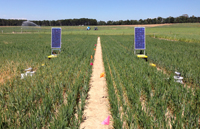Developing better techniques for monitoring CO2 storage
4 September 2014

Atmospheric monitoring equipment
at the CSIRO Ginninderra
Experimental Station controlled
release facility.
Ensuring the effective and permanent storage of carbon dioxide is essential for any carbon capture and storage project.
A controlled release facility, hosted at the CSIRO's Ginninderra Experimental Station in north Canberra, is designed to simulate surface emissions of greenhouse gases such as carbon dioxide (CO2) from the ground into the atmosphere under controlled conditions.
This facility jointly run by the Cooperative Research Centre for Greenhouse Gas Technologies (CO2CRC) and partner agency Geoscience Australia, is an Australian first, and is one of only a few similar facilities around the world. The work at the Ginninderra facility complements the monitoring work being undertaken by the CO2CRC and Geoscience Australia at the Otway Project in Victoria.
The measurement of known releases of greenhouse gases in the field using a controlled release facility is the most effective approach for assessing the effectiveness of monitoring techniques.
Geoscience Australia Project Leader Dr Andrew Feitz said one of the key challenges is to develop technology for detection of small-scale leak features over a wide area.
"This project has seen development of world leading research into the use of mobile sensor and remote sensing technology at the site," Dr Feitz explained.
The project facility was designed and developed under a joint venture between the CO2CRC and Geoscience Australia to evaluate the effectiveness of different near surface monitoring techniques for detecting and quantifying leaks against a known CO2 source.
The research conducted at the facility has been a highly interdisciplinary collaborative project with a range of national and international partner organisations. The research team has come from a broad range of scientific disciplines, including atmospheric science, geochemistry, plant biology and engineering.
The mix of different disciplines has provided insight into the behaviour of a controlled released CO2 plume in the near surface, the effectiveness of different monitoring approaches, and identified the key challenges for monitoring at geological sites now and into the future.
Some of the key results from the monitoring experiments conducted at the Ginninderra Experimental Station will be presented at the upcoming Greenhouse Gas Technologies Conference in Austin, Texas in early October.
Further detail on the project is available via the National Geosequestration Laboratory website.




